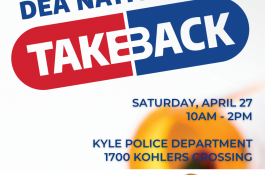Pavement Management Program
As the City of Kyle continues to grow, the number of miles added to the city’s roadway system also continues to expand. The City of Kyle has created a Pavement Management Program in order to better plan and budget for street repairs and maintenance in the future. The program will help us know how much of the City budget needs to be set aside each year to maintain a certain level of pavement condition on City streets.
Pavement Management is the process of managing the life cycle of roadways to maximize the pavement life and to minimize the maintenance costs. This process inventories the streets into maintainable segments followed by a survey to determine the surface condition and rideability. This process helps determine what maintenance practices should be used based on the pavement condition to help maximize the life of the roadway.
As part of the pavement assessment, each city street will be evaluated and an Pavement Condition Index (PCI), or Pavement Score, will be assigned to each street segment. The PCI considers the smoothness of the roadways and cracks, rutting, utility cuts and potholes in the pavement surface. A street with a PCI of 99 is in excellent condition and needs no repair or treatment. Usually a PCI of 19 or less indicates pavement and road base failure, and a reconstruction is required. Estimated PCI scores and ratings are listed in the following table.
| ESTIMATED PCI SCORES | RATINGS |
| 80 – 99 | Excellent |
| 60 – 79 | Good |
| 40 – 59 | Average |
| 20 – 39 | Fair |
| 0 – 19 | Poor |
The PCI is used as input into the city’s pavement management software program and each year the program systematically reduces these scores due to weather, age and traffic, creating the estimated PCI scores. When preventive maintenance is completed on any particular roadway each year, the score on these roadways will be adjusted.
The estimated PCI scores will be used to enable the city to prepare a list of roadways for the “preventive maintenance” budget each year. The preventive maintenance budget will consist of work like crack sealing, pothole repairs, base repairs, chip seals, limited overlays, mill and overlays and rehabilitation/reconstruction of roadways.
2023 Tentative Pavement Assessment Schedule
- February 28 - Field Data Collection starts
- March 28 - Field Pilot
- April 18 - Condition Assessment Results
- May 30 - Draft Report
- June 15 - Final Report
- June 30 - ROW Asset Database
Types of Preventative Maintenance Work
- Crack Sealing: This work consists of cleaning and sealing the cracks in the pavement with an asphalt sealant to prevent moisture from entering into the flexible base and/or subgrade material. This is the least expensive form of preventive maintenance and typically looks like an “asphalt” spider web placed on the pavement.
- Pothole Repairs: This work consists of removing loose material from a small, shallow repair area, applying tack coat to surfaces of these areas, placing the repair material to grade and compacting to conform to the existing roadway surface using mechanical tampers or rollers to achieve full consolidation.
- Base Repairs: Since these repairs are much larger and deeper than potholes, this work consists of saw-cutting the repair area and removing the loose, existing asphalt pavement and base material. Once the loose material is cleaned-out, tack coat is applied to surfaces of the repair area and the new material is placed in lifts of no more than 4” deep. The repairs are finished to grade and compacted to conform to the existing roadway surface using rollers. This work is done to repair areas to extend the life of the roadway.
- Blade Level-up: This work consists of the placement of a thin layer of asphalt pavement to fill-in areas of the pavement that hold water due to the shifting subgrade. Since standing water can be detrimental to a pavement section over time, it is good to make sure water drains properly.
- Chip Seals and Limited Overlays: A chip seal consists of spraying a thin layer of asphalt over the pavement followed by applying a thin layer of small aggregate. Once this is done, a thin hot-mix asphalt pavement overlay (approximately 1” thick) is placed over the chip seal. This is done to waterproof the existing street surface and to increase skid resistance and life of the pavement section.
- Mill and Overlays: This work consists milling 2” or 3” of the existing pavement section and placing a single layer of hot-mix asphalt pavement which is used to restore the street to its original shape and ride.
- Rehabilitation/Reconstruction of Roadways: When the existing pavement has deteriorated to the point it cannot be repaired or the subgrade has shifted and is now holding water, we have to rehab or reconstruct it. This work consists of reconstructing the entire roadway section, replacing sections of concrete curb and fixing the drainage issues so water drains properly.




